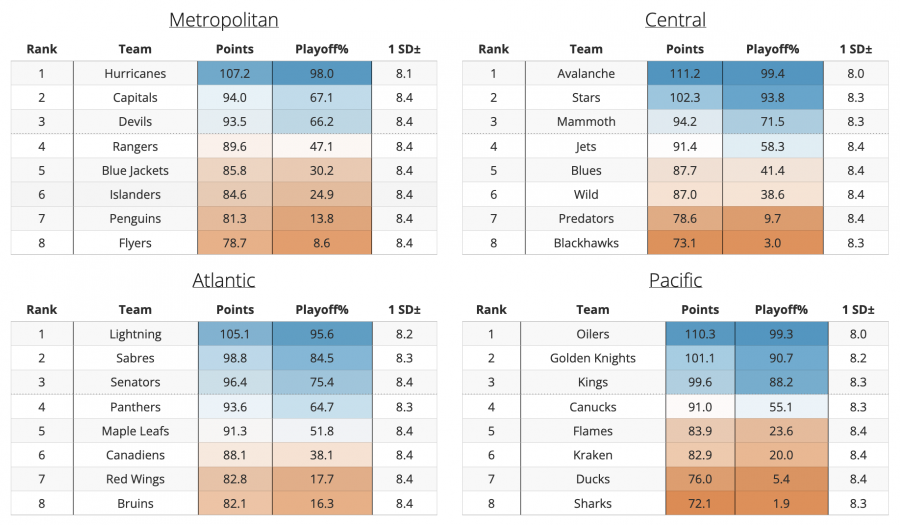How is it already October? How is the season already starting in two days? For months I’ve seen r/hockey count down the days until the start of the season and yet I just don’t believe it’s here. I guess this is every year, eh? It’s time, once again, for our eagerly awaited Team Point Projections article. Like many other articles on the site, we do this every year. It’s gotten to the point where I’m now forgetting about these recurring articles and actually didn’t do our end-of-summer contract projection evaluation one. I’m sorry (in fairness to me, I did post a quick thread on “X”/Blue sky back in July). That’ll be up in a week or two I promise – please forgive me.
Entering the ’25-26 season, the uncertainty of projecting contracts with the looming salary cap increase has transitioned into the uncertainty of projecting how good teams will be. Since we’ve been doing these here on the site I’m not sure I’ve seen more change from one year to the next. It feels sort of like a wave that’s now a mile closer than it was last year. Several consistent standing-points juggernauts are already out of contention before we’ve even started (except the stupid Lightning, who continue to somehow stay relevant), and a few young teams might have an opportunity to jump at that opening. Except San Jose, Anaheim, and Chicago. Sorry guys, maybe that wave will be bigger next year. Let’s get to it.
Model Info
This is an updated version of our explainer from the previous description here .
Our team probabilities are generated in a three-step process. We use a model to project “future” value for all players, use these player projections to build a game probability model that projects the winning % of any given team matchup using logistic regression, and then feed these individual game probabilities into a Monte Carlo simulation that generates the outcomes for all games in a season. To complete this process, each team’s player projections are aggregated into Forward, Defensemen, and Goalie groups, and various metrics are used for each group which are then fed into the game probability model. With these inputs, we can generate home and away team winning percentage values. Once we have all home/away probabilities projected for each game in the season, we prepare the simulation.
For each game in the simulation, we only care about the projected winning % for the home team. Take a game between a home team and an away team. The process laid out above gives us a winning % for each team. We replace the away team’s projected probability with a random % between 0 and 1. If the home team’s projected winning % is higher than the random number, they “win” the game (they “lose” if it is lower). This is done for each game in the season and then repeated tens of thousands of times. Once the simulation is complete, we check how many times each team won a game, sum the total games won, and arrive at each team’s projected point total.
The first step is generating multi ple player-level models, which produce ratings for all players in the league. For skaters, we found our xSPAR metric (Expected Standing Points Above Replacement) as well as a custom “game score” model (built using Box Score metrics) works best for predicting future team game outcomes. Our SPAR and RAPM metrics were also tested but they did not perform quite as well for this specific task. The “game score” model we are using is similar to Dom Luszczyszyn’s Game Score model; however, we tested various box score metrics and weighted them through a “grid search” approach to optimize predicting future team game win probability. For the simulation, we set the schedule for all teams, add in the projected game probabilities, and then run the simulation.
We still use a roster-level system, project various metrics for every player for next season (notably xSPAR and our own “game score” metric), determine the roster for every team*, aggregate those individual projections into team ratings for forwards / defensemen / goalies, and compute game probabilities for every game in the ’25-26 schedule. We then run a Monte Carlo simulation 50,000 times with all of that in place to project point totals for all teams in the league. As the season progresses, this simulation is re-run daily with updated data.
* For the ’25-26 NHL season, we are now tracking and setting rosters ourselves. In prior years we’ve used rosters in collaboration with other sources (CapFriednly, NHL Rosters, etc.). While it took quite a bit more work to set this up, we’re now doing this in-house and are happy with how it came together. We’ll try to note any significant injuries in the previews below. Please let us know, throughout the season, if things seem off or if we’ve missed something.
Team Projections
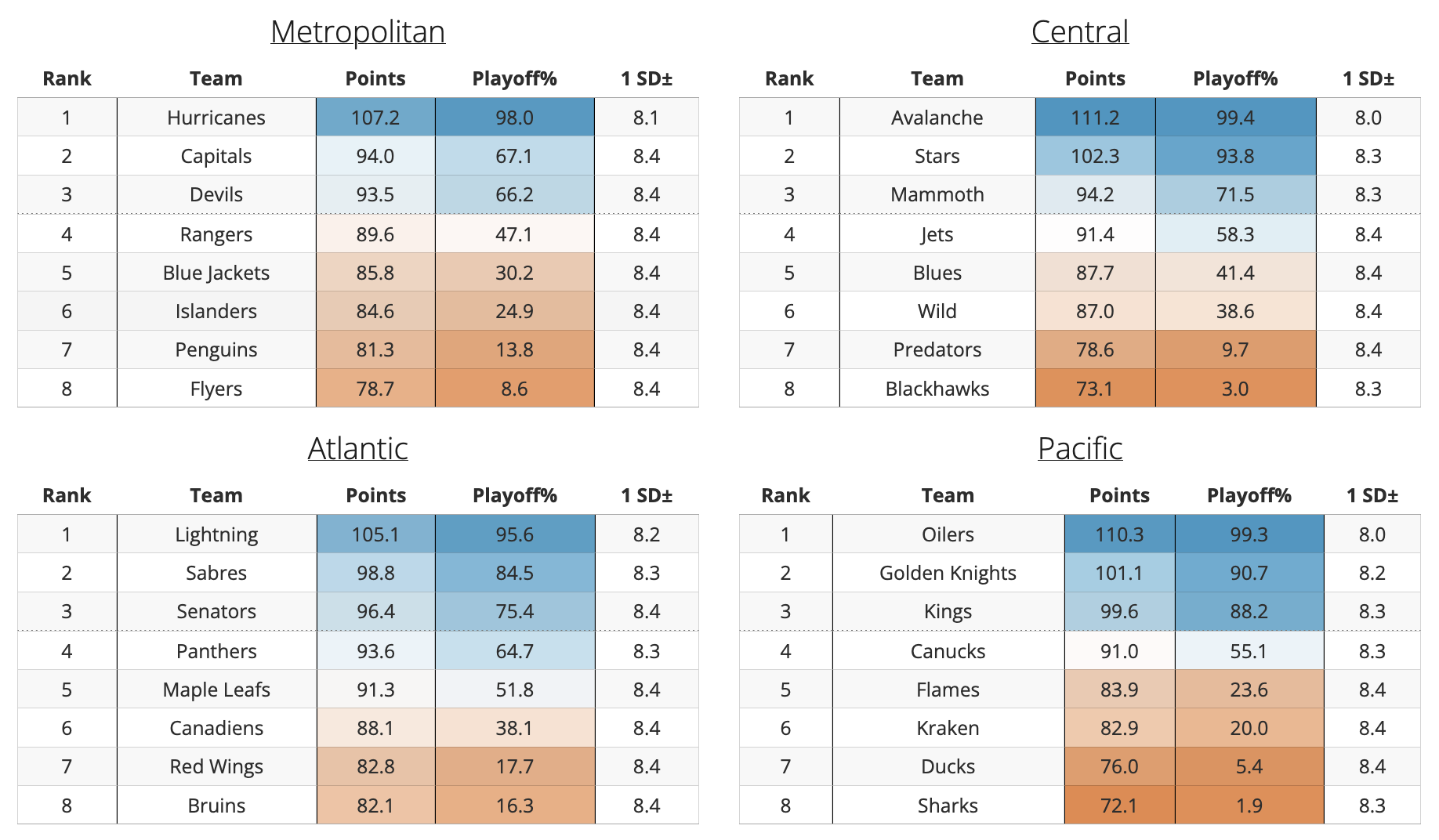
For those familiar with our Team Projections on the site, these are updated daily as the season moves along. We attempt to account for injuries to the best of our ability based on “expected” return dates and anticipated substitutions, but there is always uncertainty when it comes to missed time in the NHL. As of right now, we’re using our own (noted above) rosters along with our best estimate for when injured players will return in the season and who will likely take their place during their absence. Ok, onto the team discussion.
- Metropolitan: 87.7
- Atlantic: 92.5
- Central: 89.6
- Pacific: 87.5
Based on these median values, every division has gotten worse while the total sum of standings points we’re projecting has only dropped by ~14 (from roughly 2910 to 2896). Usually, the difference in this total from season to season can be accounted for by the change in team strength within each division, and we’re seeing that here. Outside of the few “best expected teams” by our model (Colorado, Edmonton, Carolina), there are a lot of teams vying for playoff spots – and they’re all quite close. Last season it felt like we had a much clearer separation between the good teams and the bad. Heading into this season I think it’s fair to say that we’re seeing a changing of the guard. With numerous consistent division leaders dropping in our projections (I’ll get to that below) and several young teams making significant gains in their development, only one thing is certain: The Wild are winning the Cup.
Metropolitan Division
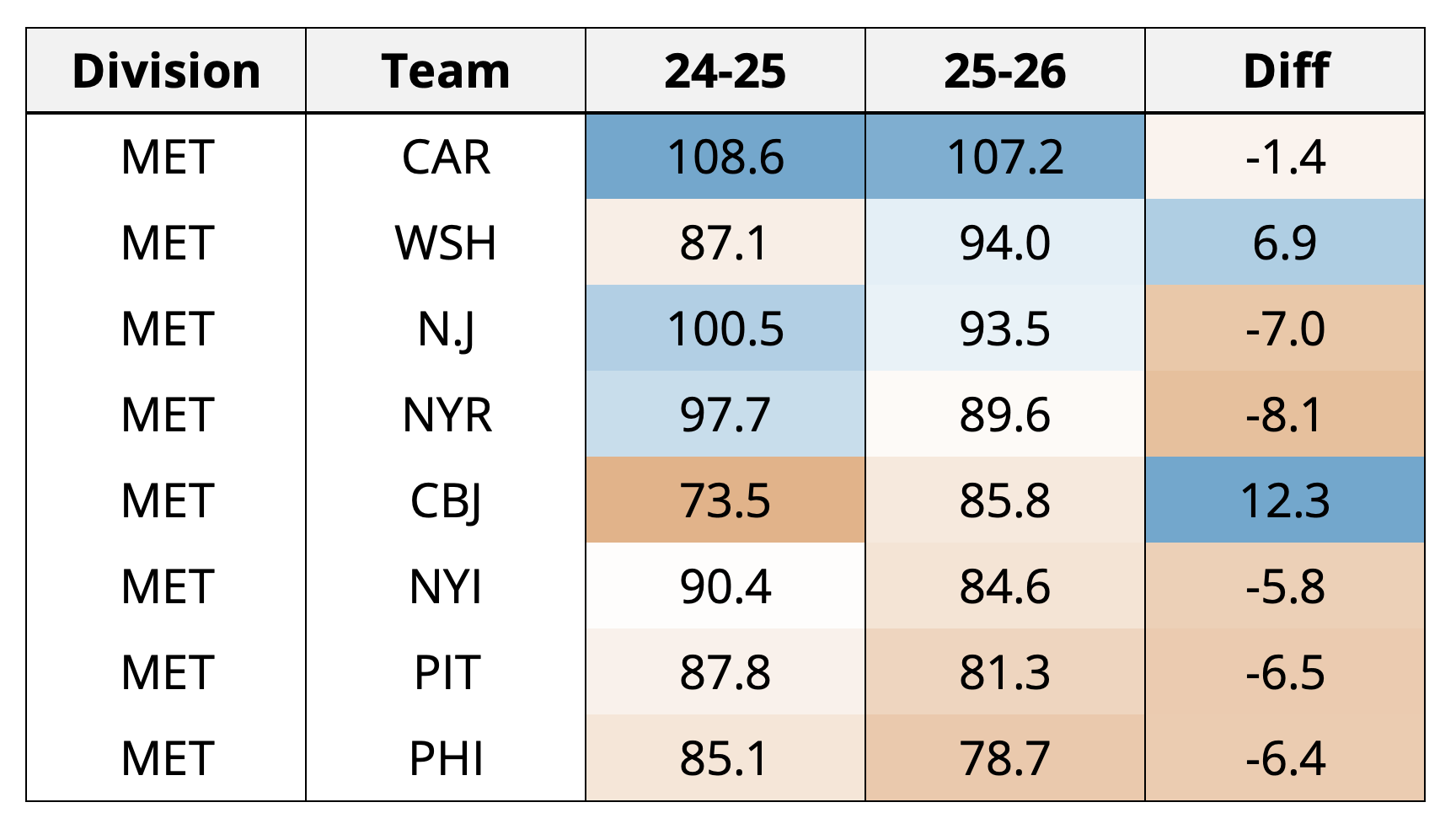
As we’ll see with each Division this year, some big (bad?) changes are happening in the Metro. With only one team within two points of our preseason projections from last season (Carolina), things are ripe for either joy (our models are right) or despair (our models make us feel sad). The easy outlier here is Columbus; after extremely low expectations a year ago, the young Blue Jackets squad enters this year with some promise. With only 5 skaters on their current roster over 30 and a majority of their top-six forwards under 25, it’s no surprise only two teams have improved more than the Blue Jackets in our projections (Montreal and Vegas). Within the division, Washington is the only other team with an increase from a year ago. We got a lot of flak for our ’24-25 Capitals projection, and in hindsight… yeah – a team posting 24 points more than we said might make some people mad. But you know what, it’s important to experience the full spectrum of human emotion sometimes. Washington brings back a similar squad with a few young additions that should keep them competitive in a weaker division.
Which mainly includes the New York and Pennsylvania teams. A few of these make sense – Pittsburgh is hanging on by the thread of their prior glory with one of the oldest lineups in the league, and the Islanders are the Islanders. The Rangers here are, for me, quite fascinating. A team that’s succeeded almost entirely from shooting and goaltending over the course of this partial decade, they didn’t necessarily struggle in either category at even-strength last season (6th in team shooting %, Shesterkin among the top 10 in GSAx), but their powerplay absolutely fell off, and only Adam Fox and Artemi Panarin finished with xGAR over 10. They’re rostering some elite players (Fox, Shesterkin), but things are bleak in New York this year. The Flyers, on the other hand, are also looking bleak. After several years of icing quite a few players that have shown up in our infamous year-end award threads on “X”, they now have a team with little direction. Not that a projected points total of 85 is anything special, but falling short by 9 points in ’24-25 and entering this season with a roster where your only standout players are depth players that only Evolving Hockey could love doesn’t inspire a lot of confidence. We still love Foerster, Cates, and Sanheim you can’t make me say we don’t. Look out for those year-end awards threads this year!
Atlantic Division
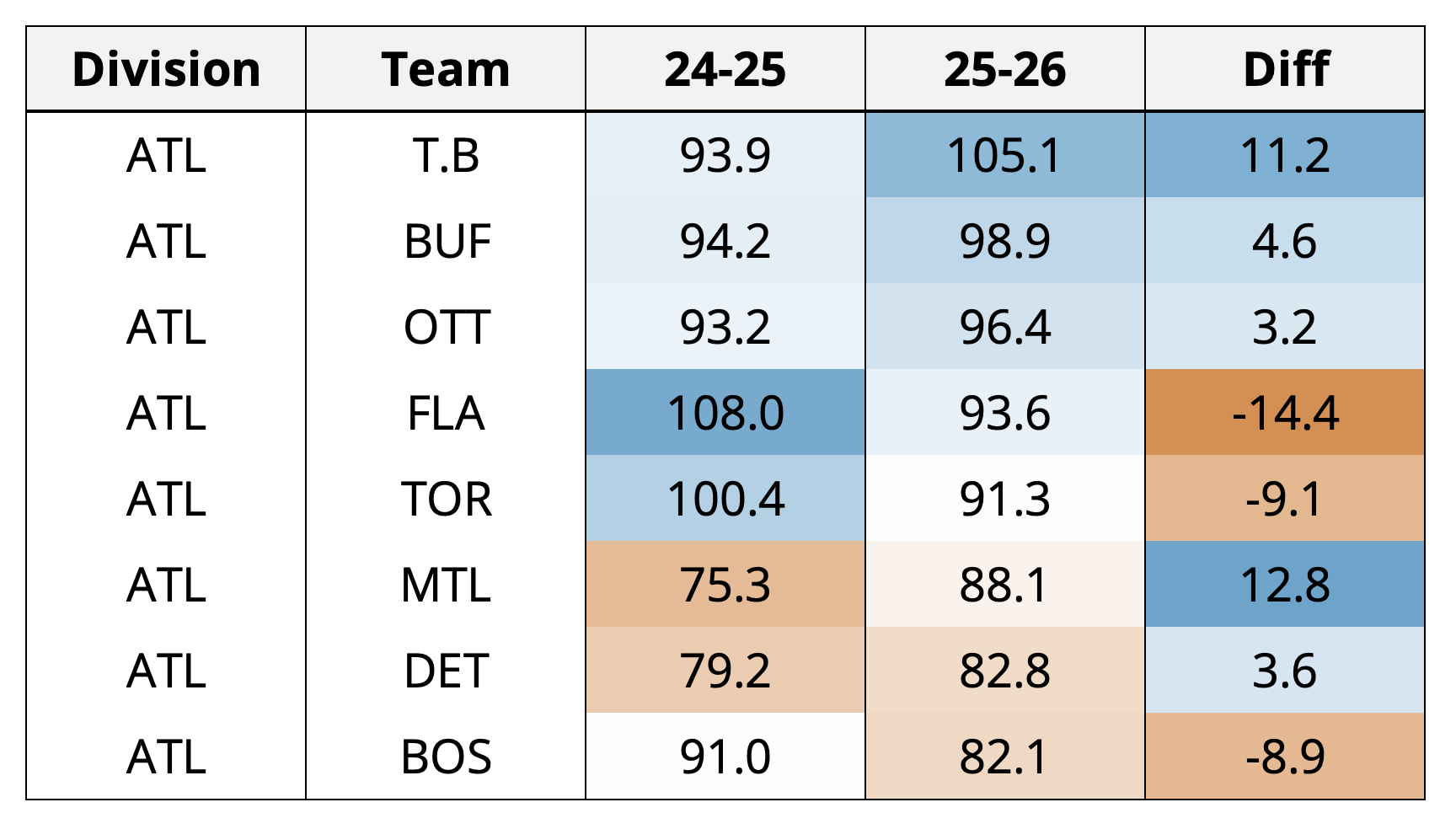
I’m not sure I have enough room here to talk about what’s going with the Atlantic this season. The obvious ones are Florida (consecutive Cup winners looking for a third) and Toronto (because we obviously need to talk about the Leafs in a preview like this). The more interesting teams here are Buffalo, Montreal, and Tampa Bay. But first let’s get the Panthers out of the way. Losing Barkov for an entire season and Tkachuk for half of it is going to hurt any team. We actually ran our simulation with both included for the full season just out of curiosity and Florida jumped nearly 10 points in our projections here – maybe even with both players uninjured, a 104-point projection is still a hot take for the back-to-back Cup winners, but it’s pretty easy to understand why they’re so low here. The Leafs, on the other hand, are also easy to understand. They’re just not that good. Look, I like their core just as much as the next non-Leafs fan who doesn’t hate them, and they do have some promising young players in Knies and MacCelli, but losing Marner is actually quite a big deal for this team, and outside of their dwindling core we’re left with several aging players past their prime and some definite question marks down lineup. Go Leafs, though (Shawn wrote this).
Then there is Buffalo. The new late-2010s Carolina Hurricanes of hope for the stats guys? We’re now on at least three seasons of optimistic Sabres projections, and you know what? Sure, they’ve let us down before. Sure, they’ve underperformed and made us (Evolving Hockey) give hope to a fanbase that hasn’t experienced a playoff berth since the internet was invented, but you also know what? We’re doing it again. Look, they’re a very young team with a surprisingly strong group of players based on our metrics, and we live and die by our models. In all seriousness, age matters quite bit in our system, and the only players over 30 the Sabres appear to be rostering are Jason Zucker and Justin Danforth. Beneath the star power of Rasmus Dahlin and Tage Thompson, Ryan McLeod, Jack Quinn, and Owen Power fill out a roster that’s, on paper, actually pretty deep. With the new, young additions of Doan and Kesselring following the Peterka trade, there’s a ton of uncertainty here. But there’s also a lot of hope. At least for us. Shoot I didn’t talk about Montreal or Tampa yet. Ok, we’re probably too high on Montreal and… I don’t know, I’ve learned that I shouldn’t doubt the Lightning. Too high there too because I don’t want to believe.
Central Division
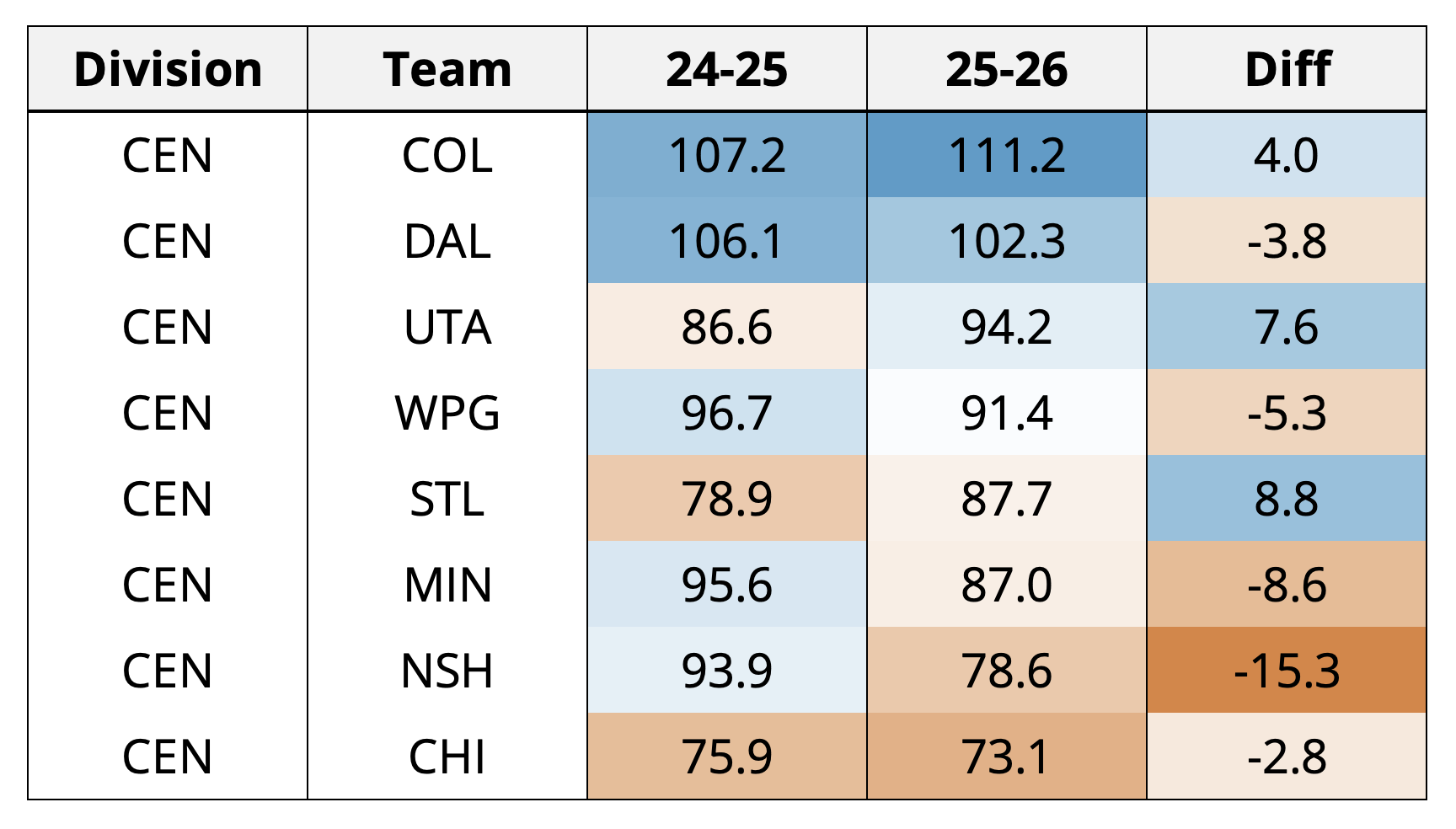
Possibly the most boring division heading into this season, I now have to talk about this group of awe-inspiring teams. Colorado and Dallas are the same. Sure, we’ve got some movement, but like, are they really that different? Let’s, instead, continue the theme of discussing young teams: the Utah Mammoth Hockey Club. Even heading into last season there was some promise, and we saw it play out with a surprisingly strong season even if they finished with only 89 points in the standings. At even-strength, Utah held the 6th best CF% and xGF % last season in front a great year from Karel Vejmelka (8th in goalie GAR in ’24-25) – I have a memory of us really liking him a couple years ago and then I drafted him in fantasy and it sucked. Or was that Vaněček? With the anticipated addition of Peterka to the Mammoth Hockey Club along with an interesting lack of below-replacement players (ignoring Cole and O’Brien), Utah is set up for a breakout year. St. Louis, on the complete opposite end of the spectrum of roster construction, is closer to them than one might expect? The Holloway and Broberg offer sheets paid dividends last year, and the Blues proved they still have a surprisingly effective group of players at the top. Except they traded our Calder favorite from last year, Zachary Bolduc, which still makes absolutely no sense to me. We still have them fighting for a wild card spot, so let’s not get too carried away.
Now on to the Wild. The team prophesied to win the Cup this year. Let’s check in on those good old fashioned Evolving Hockey projections, eh? Sh*t. Outside of the massive-verging-on-absurd contract they just gave Kaprziov (I mean, what else were they going to do), Minnesota did very little this offseason, even with their newfound freedom from Parise and Suter. I don’t necessarily blame them, but, like other central teams, they’re bringing back the same squad we saw last year. Matt Boldy and Marco Rossi are the clear young bright spots here, and one can imagine this season playing out where everything goes right: Faber takes the next step, Buium and Yurov are Calder favorites, and Gustafsson wins the Vezina. In reality, they enter ’25-26 with several injury questions, an aging Jared Spurgeon and Jonas Brodin, and a glaring lack of good depth players to fill out their roster past their top-end. That said, it’s happening. We’re doing it. The Cup is coming home to America’s Team.
Pacific Division
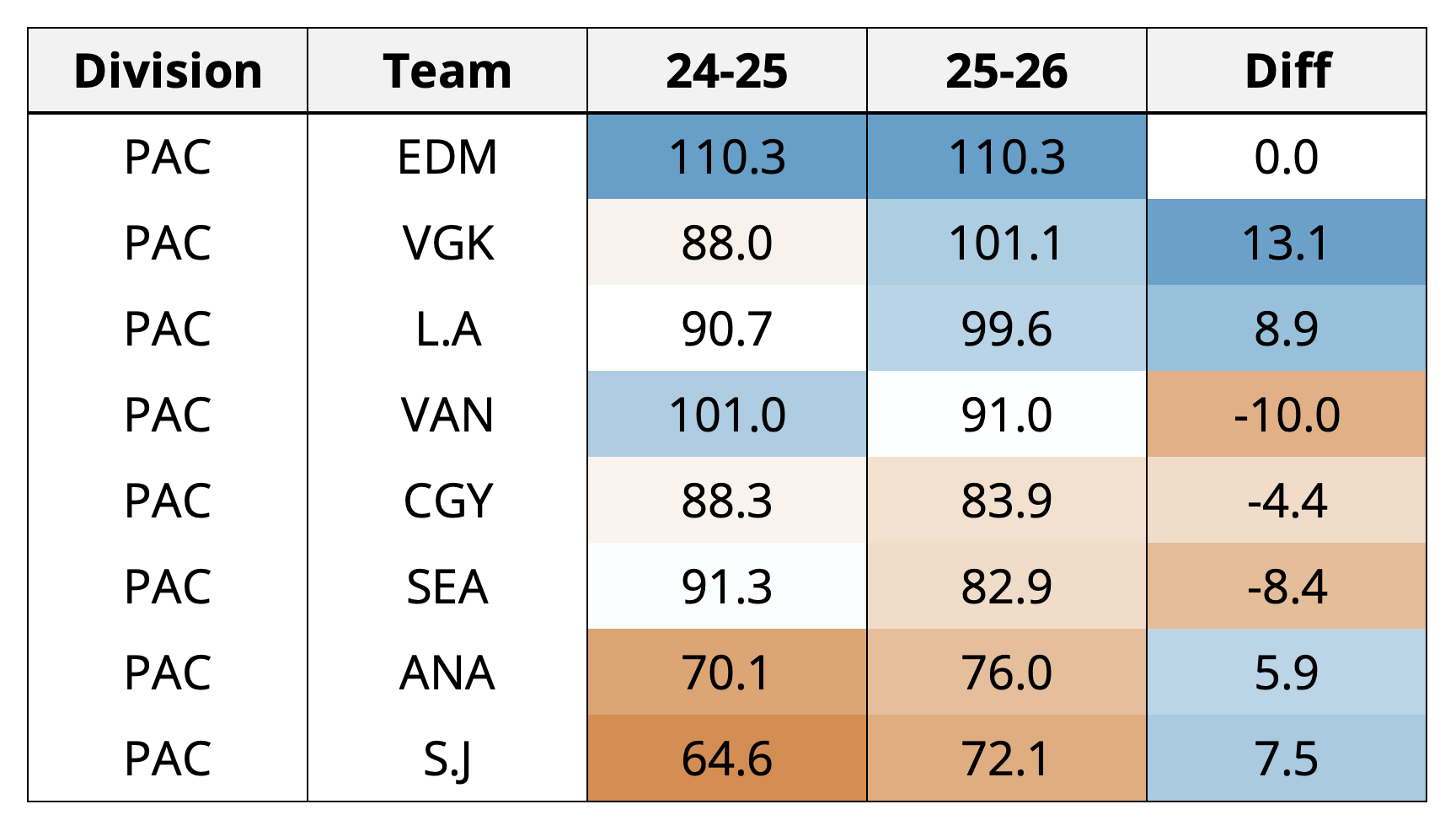
Ok, we were wrong. Vegas was actually really good last season, as much as it pains me to say. Honestly, I’m not sure what we were cooking with that 88 point projection (I have vague memories about explaining this on the podcast, but they’re fading quickly). Always last in both time zones and our previews, the Pacific Division includes four teams who improved the most compared to a year ago and one team that stayed exactly the same. Like Colorado and Dallas, I don’t think there’s much to say about Edmonton. McDavid, Draisaitl, can they finally win a cup? Is Stuart Skinner the answer in net? Should Evan Bouchard be on Team Canada (yes)? We get it, they’re good. Los Angeles, however, is far more interesting. With a decent number of signings this offseason (namely Kuzmenko, Armia, and Ceci), along with an exceptional season in both their on-ice metrics (top-5 in both EV CF% and xGF%) and the standings (105 points??), it’s not surprising we’re seeing the jump in the projection here. While they let a few of their underperforming players go (namely Trevor Lewis), they’ve also added some questionable players to fill in (Ceci and Dumoulin). Still, the combination of overlooked depth and a phenomenal season from the unpredictable Darcy Kuemper places them as one of our division playoff picks.
Seattle, conversely, has fallen out of our good graces. I mean, really: what is going in Seattle? After a 100-point season in ’22-23, they’ve completely tanked two seasons in a row. With questionable management decisions and even more concerning free agency acquisitions along with a roster that’s set to miss the playoffs once again, it’s a shame so much promise had to go to waste. The team has some curious prospective players, but there’s unfortunately not much to look forward to here. Rounding out our worst-projected division in the league, Anaheim and San Jose are just chilling. But, we’ve also got some vibes going on here too. Not necessarily good vibes, but they are vibes nonetheless. You can almost imagine a scenario where one of these teams does something. Ok, it’s kind of hard to imagine. Regardless, San Jose is icing one of the youngest teams in the league, and the Anaheim Ducks have a 25-year-old goalie who finished 9th in GAR last season. Celebrini, Smith, Misa, Askarov, McTavish, Gauthier, Zellweger, Lacombe, Carlsson. I’m just naming a bunch of names here that will make me look good in four years. I’m definitely going to be watching these teams for my own twisted but also curious enjoyment.
